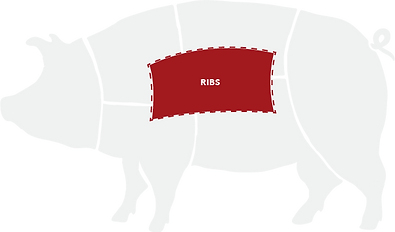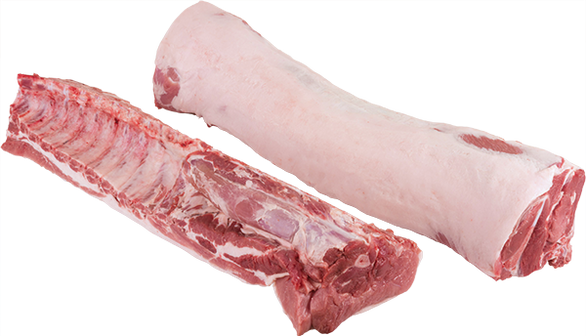Get to Know
Meat Chart

Pork Belly
Pork Belly, refers to the underside of the pig. It is one of the fattiest and most flavorful parts of the pig, often used in cooking to make cured pork, bacon, and other delicacies. The pork belly typically features rich layers of fat and distinct muscle textures, offering a tender and succulent taste. In cooking, pig belly is commonly roasted, fried, smoked, or slow-cooked to enhance its rich flavors and textures.

Pork Leg
The pork leg, also known as ham, is a versatile and flavorful cut of meat derived from the hind leg of the pig. It is prized for its tender meat and rich flavor profile, making it a popular choice for various culinary applications. Whether roasted, grilled, smoked, or braised, pork leg offers succulent and juicy meat that pairs well with a variety of seasonings and accompaniments. It is often enjoyed as a centerpiece for festive occasions or sliced thinly for sandwiches and charcuterie boards. Additionally, pork leg is a favorite choice for curing and aging, producing delicacies such as prosciutto and ham.

Pork Loin
The pork loin is a premium cut of meat sourced from the back of the pig, prized for its tenderness and succulence. It is a lean and versatile cut, characterized by its fine texture and mild flavor. Pork loin can be prepared in various ways, including roasting, grilling, or pan-searing, making it a favorite choice for both everyday meals and special occasions. Due to its leanness, pork loin is often wrapped in bacon or marinated to add moisture and flavor. When cooked properly, it yields tender and juicy meat that pairs well with a variety of seasonings and sauces. Whether served as a roast, chops, or medallions, pork loin is a delicious and satisfying option for any meal.

Pork Ribs
Pork ribs are a popular and flavorful cut of meat derived from the ribcage of pigs. They are known for their rich marbling and tender texture, making them a favorite choice for grilling, smoking, or barbecuing. Pork ribs come in various styles, including baby back ribs, spare ribs, and St. Louis-style ribs, each offering a unique balance of meatiness and fat content. When cooked low and slow, pork ribs become fall-off-the-bone tender, with a deliciously caramelized exterior and juicy interior. They are often enjoyed slathered in barbecue sauce or dry rubs, served alongside classic accompaniments like coleslaw, baked beans, and cornbread. Whether enjoyed at a backyard barbecue or a fine dining restaurant, pork ribs are a beloved dish that satisfies carnivores of all tastes.

Pork Sholder
The pork shoulder, also known as pork butt or Boston butt, is a flavorful and versatile cut of meat obtained from the upper portion of the pig's shoulder. Despite its name, it does not come from the actual rear end of the pig. This cut is characterized by its marbling, which contributes to its tenderness and rich flavor when cooked low and slow. Pork shoulder is ideal for braising, roasting, smoking, or slow-cooking, as it becomes tender and succulent with prolonged cooking times. It is often used to make pulled pork, a beloved dish in many cuisines, where the meat is shredded and mixed with barbecue sauce or other seasonings. Additionally, pork shoulder can be sliced into steaks or chops, providing a flavorful option for grilling or pan-searing. Whether used in hearty stews, sandwiches, or as the centerpiece of a barbecue feast, pork shoulder is a versatile and delicious cut that is sure to please any meat lover.
Pork Sundries
These unique cuts provide an opportunity for creative cooking endeavors, whether it's adding depth to soups and stews, creating succulent braised dishes, or enhancing the flavor profile of sauces and broths. With their versatility and distinct characteristics, pork sundries are a valued component in the culinary world, allowing chefs and home cooks alike to craft a wide range of delicious and satisfying dishes.
Pork Offal
This includes organs such as the liver, heart, kidneys, lungs, stomach, and intestines. While often overlooked by some, pork offal is highly valued in many cuisines around the world for its rich flavors and versatility in cooking. These organs can be prepared in various ways, including frying, grilling, stewing, braising, or even curing. They add depth and complexity to dishes, contributing unique textures and flavors. From traditional dishes like liver pâté and grilled kidneys to more adventurous recipes like chitterlings and head cheese, pork offal offers a wide range of culinary possibilities for those willing to explore and experiment with these often underrated ingredients.














































